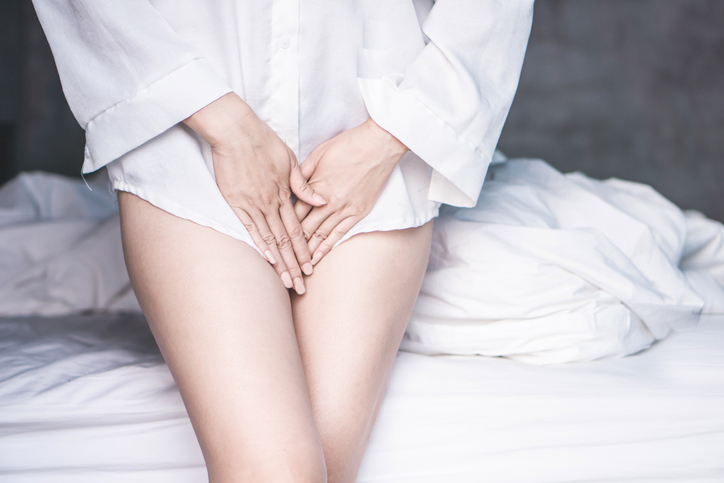
Lichen sclerosus is a rare skin condition that usually occurs in the genital or anal area. It creates white, patchy areas of skin that may be thinner and tighter than other areas of skin. Skin affected by lichen sclerosus is often more susceptible to bruising and tearing, which can lead to painful sex when it is located on the genitals.
Who can get lichen sclerosus?
While men, women, and children of all ages can get lichen sclerosus, it is most common in postmenopausal women. Obese men or those with uncircumcised penises may be more likely to experience this condition because lichen sclerosus can develop on the foreskin or shaft skin with penile retraction. Finally, individuals may be at higher risk of getting lichen sclerosus if they have an autoimmune disease or a history of lichen sclerosus in their family.
What causes lichen sclerosus?
The cause of lichen sclerosus is unknown, but an overactive immune system, hormonal imbalance, chemical irritation from urine, recurrent fungal infections, and previous damage to the skin are thought to contribute to its development. Lichen sclerosus is not contagious and cannot be passed from one person to another during sexual intercourse.
What are the symptoms?
Although lichen sclerosus usually affects the genital or anal area, it can also affect the breasts, torso, and upper arms. Some people with mild lichen sclerosus may never notice symptoms, but for moderate to severe cases, the most common symptoms include:
- Smooth white patches of tight skin that may grow in size over time
- Itchiness
- Skin that tears and/or bruises easily
- Redness
- Discomfort or pain
- Blisters
- Painful sex
How is lichen sclerosus diagnosed?
A health care provider can usually diagnose lichen sclerosus through obtaining a patient health history and conducting a physical exam of the area of skin that is impacted. Sometimes, a biopsy of the affected area may be required. This means that they will take a small sample of the skin and send it to a lab to be examined more closely under a microscope.
How is it treated?
Though it is uncommon, lichen sclerosus can occasionally improve on its own. Most of the time, a health care professional will recommend creams or ointments to reduce itchiness and scarring and improve the look of the skin. The most common first-line treatment for lichen sclerosus is a steroid ointment or cream that an individual can apply to the affected area. Removing the foreskin may be an option for people with uncircumcised penises if that is where they are experiencing lichen sclerosus. However, surgery in the genital or anal area is usually not recommended as a treatment because lichen sclerosus can reoccur. It is a good idea to schedule regular follow-up visits with a health care provider so that they can monitor any changes in the area.
Resources:
Cedars-Sinai. Medically reviewed by Michael Lehrer, MD; Rita Sather, RN; Raymond Kent Turley BSN, MSN, RN. (2021). Lichen Sclerosus. https://www.cedars-sinai.org/health-library/diseases-and-conditions/l/lichen-sclerosus.html.
Mayo Clinic. (2020, October 10). Lichen Sclerosus. https://www.mayoclinic.org/diseases-conditions/lichen-sclerosus/symptoms-causes/syc-20374448.
WebMD. Medically reviewed by Debra Jaliman, MD. (2020, September 10). What is Lichen Sclerosus? https://www.webmd.com/skin-problems-and-treatments/lichen-sclerosis.
You may also be interested in...
Other Popular Articles

What Is the Average Penis Size?
If you have ever wondered how your penis compares to others in terms of size, you are not alone. Many men are curious to know how their penises stack up compared to the average. Unfortunately, general curiosity can sometimes give way to full-on obsession and anxiety about penis size. This can be an unhealthy and often unnecessary fixation, especially because most men who think their penises are too small have perfectly normal-sized penises.

What Is Jelqing, and Does It Actually Work?
The term “jelqing” refers to a set of penis stretching exercises that some believe can make the penis bigger. Although the practice has gained attention and popularity in blogs and internet forums in recent years, there is no scientific evidence that it is an effective way to permanently increase the size of one’s penis. In fact, in some cases, jelqing may actually cause damage to the penis, so it is a good idea to get all the facts before setting off to try it.

What Is Sensate Focus and How Does It Work?
Sensate focus is a technique used to improve intimacy and communication between partners around sex, reduce sexual performance anxiety, and shift away from ingrained, goal-oriented sexual patterns that may not be serving a couple.

Can Sex Reduce Menstrual Cramps?
The SMSNA periodically receives and publishes ‘guest editorials.’ The current article was submitted by Mia Barnes, a freelance writer and researcher who specializes in women's health, wellness, and healthy living. She is the Founder and Editor-in-Chief of Body+Mind Magazine.
Having sex while you experience menstrual cramps is healthy and can provide significant benefits. While it might not be the first activity that comes to mind when your PMS or period cramping begins, many people enjoy sex to reduce menstrual cramps, experience increased pleasure and benefit from other advantages. Learn more about having sex while menstrual cramps are happening and how it can help your body.

How Long Does It Take the Average Man to Ejaculate?
On average, it takes a man between 5 to 7 minutes to orgasm and ejaculate during sexual intercourse.

The Effect of Regular Aerobic Exercise on Erectile Function
Erectile dysfunction (ED) is the inability to achieve or maintain an erection sufficient for satisfactory sexual activity. As men get older, their erectile functioning may naturally decline due to changes in testosterone levels, cardiovascular functioning, and the potential development of other chronic medical conditions that become more common with age.

